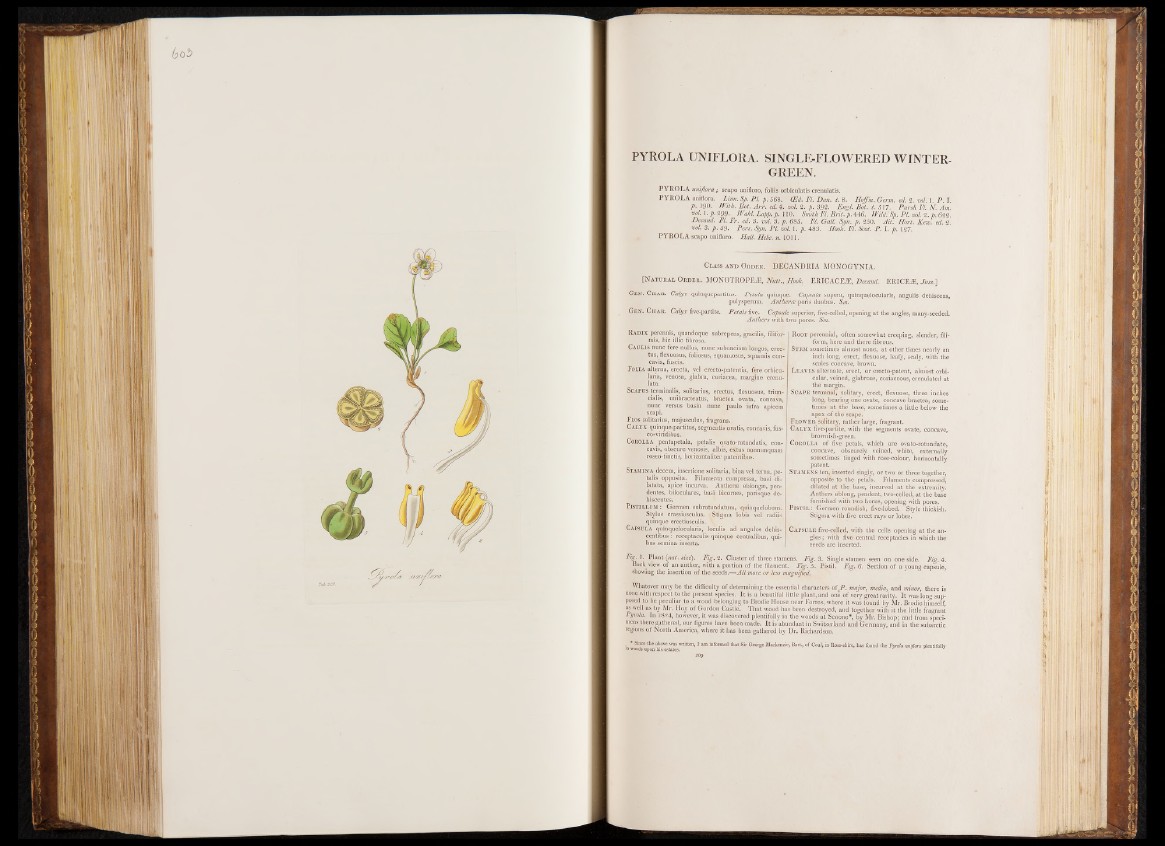
PYROLA UNIFLORA. SINGLE-FLOWERED WINTER-
GREEN.
PYROLA uniflora ; scapo unifloro, foliis orbiculatis crenulatis.
PYROLA uniflora. Linn. Sp. PI. p. 568. (Ed. FI. Dan. t. 8. Hoffm. Germ. ed. 2. ml. 1. P . I.
p . 190. With. Bot. Arr. ed.4. ml. 2. p. 392. Engl. Bot. t. 517. Pursh Fl. N. Am.
ml. l . p. 299. Wahl. Lapp. p. 110 . Smith Fl. Brit. p. 446. Wild!Sp. PI. ml. 2. p. 622.
Decand. Fl. Fr. ed. 3. ml. 3. p . 685. Fl. Gall. Syn. p. 250. Ait. Hort. Kero. ed. 2.
ml. 3. p . 59. Pers. Syn. P i. ml. 1. p. 483. Hook. Fl. Scot. P . I. p. 127.
PYROLA scapo unifloro. Hall. Helv. n. 1011.
Class and Order. DEÇANDRIA MONOGYNIA.
[Natural Order. MONOTROPEÆ, Nutt., Hook. ERICACEÆ, Decand. ERICEÆ, Joe .];
Gen. Char. Calyx quinquepartitus. Petala quinque. Capsula supera, quinquelocularis, angulis dehiscens,
polysperma. Antherce poris duobus. Sm.
Gen. Char. Calyx five-partite. Petals five. Capsule superior, five-:Celled, opening at the angles, many-seeded.
Anthers with two pores. Sm.
Radix perennis, quandoque subrepens, gracilis, filifor-
mis, hie illic fibrosa,
Caulis nunc fere nullus, nunc subunciam longus, erec-
tus, flexuosus, foliosus, squamosus, squamis. con-
cavis, fuscis.
Folia alterna, erecta, vel erecto-patentia, fere orbicu- ;
laria, venosa, glabra, coriacea, margine crenu- I
lata.
Scapus terminalis, solitarius, erectus, flexuosus, triun-
cialis, unibracteatüs, bractea ovata, concava,
nunc versus basin nunc paulo infra apicern
. scapi.
-Flos solitarius, majusculus, fragrans.
Calyx quinque-partitus, segmentis ovatis, concavis, fus-
co-viridibus. -
Corolla pentapetala, petalis ovato-rotundatis, con-
cavis, obscure venosis, albis, extus nonnuriquam
, roseo-tinctis, horizoütaliter pateiïtibus.
Stamina decern, insertione solitaria, binavel terna, petalis
opposita. Filamenta compressa, basi di-
latata, äpice incurva. Antheræ oblongæ, pendentes,
biloculares, basi bicornes, porisque de-
hiscentes.
Pistill um : Germen subrotundatum, quinquelobum.
Stylus crassiusculus. ^ Stigma lobis vel radiis
quinque erectiusCulis. \
Capsula quinquelocularis, loculis ad angulos dehis-
Centibus : receptaçulis quinque centralibus, qui-
bus semina insérta.
.Root perennial, often somewhat creeping, slender, filiform,
here and there fibrous.
Stem sometimes almost none, at other times nearly an
inch long, erect, flexuose, leafy, scaly, with the
scales concave, brown.
Leaves alternate,.erect, or erecto-patent, almost orbicular,
veined, glabrous, coriaceous, crenulated at
the margin.
Scape terminal, solitary, erect, flexuose, three inches
long, bearing one ovate, concave bractea, sometimes
at the basé, sometimes a little below the
apex of the scape.
Flower solitary, rather large, fragrant.
Calyx five-partite, with the segments ovate, concave,-
brownish-green.
CorolLa of five petals, which are ovato-rotundate,
concavé, obscurely veined, white, externally
sometimes tinged with rose-colour, horizontally
patent.
Stamens ten, inserted singly, or two or three together,
opposite to the petals. Filaments compressed,
dilated at the base, incurved at the extremity.
Anthers oblong, pendent, two-celled, at the base
furnished with two horns, opening with pores.
Pistil : Germen roundish, five-lobed. Style thickish.
Stigma with five erect rays or lobes.
Capsule five-celled, with the cells opening at the angles
; with five central receptacles in which the
seeds are inserted.
Fig 1. Plant (nat. size). Fig. 2. Cluster of three stamens. Fig. 3. Single stamen seen on one side. Fig. 4.
Back view of an anther, with a portion of the filament. Fig. 5. Pistil. Fig. 6. Section of a young capsule,
showing the insertion of the seeds.—All more or less magnified.
Whatever may be the difficulty of determining the essential characters of#P . major, media, and minor, there is
none with respect to the present species. It is a beautiful little plant, and one of very great rarity. It was long supposed
to be peculiar to a wood belonging to Brodie House near Forres, where it was found by Mr. Brodie himself,
as well as by Mr. Hoy of Gordon Castle. That wood has been destroyed, and together with it the little fragrant
Pyma. In 1824, however, it was discovered plentifully in the woods at Scoone*, by Mr. Bishop; and from specimens
there gathered, our figures have been made. It is abundant in Switzerland and Germany, and in the subarctic
regions of North America, where it has been gathered by Dr. Richardson.
, * Since the above was written,.
•o woods uponliis estates.
informed that Sir George Mackenzie, Bart, of Coul, in Ross-shire, has found the Pyrola uniflora plentifully